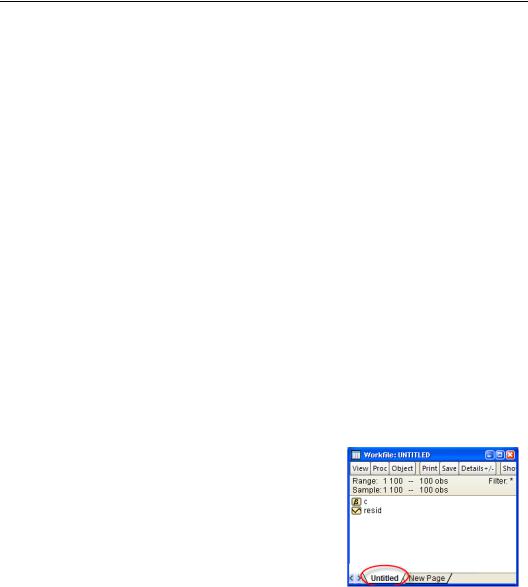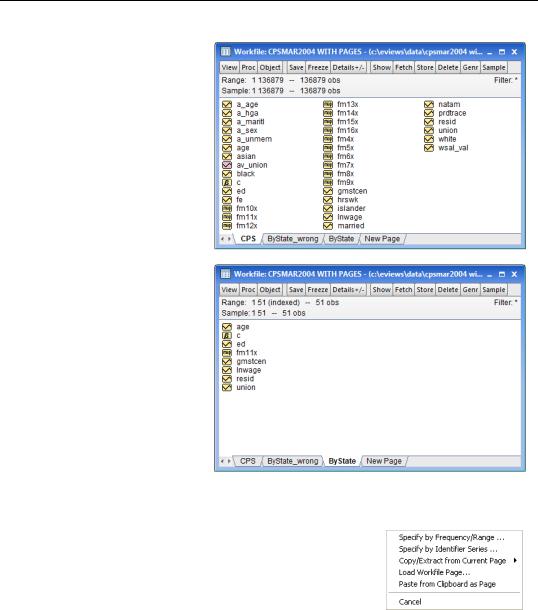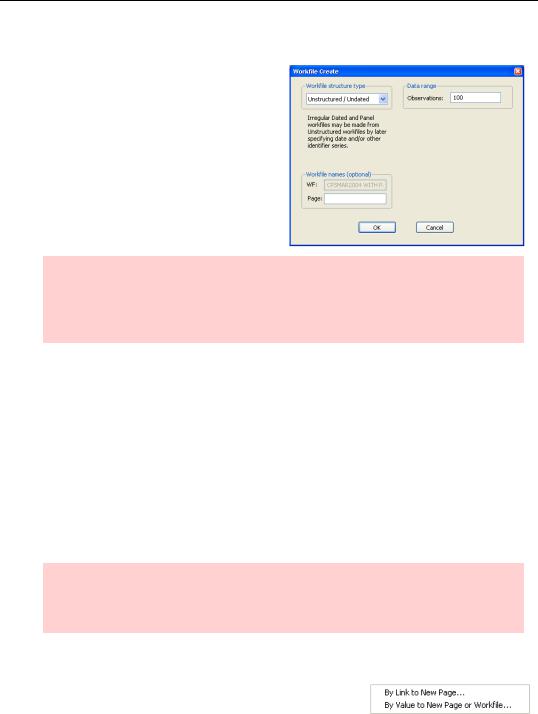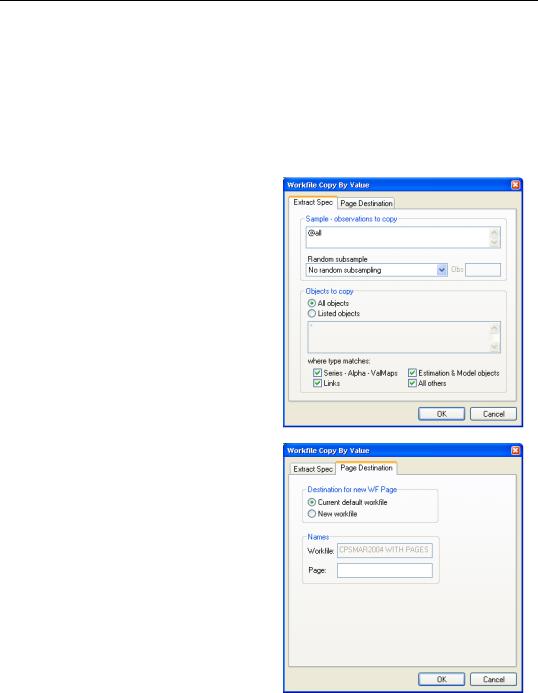
- •Table of Contents
- •Foreword
- •Chapter 1. A Quick Walk Through
- •Workfile: The Basic EViews Document
- •Viewing an individual series
- •Looking at different samples
- •Generating a new series
- •Looking at a pair of series together
- •Estimating your first regression in EViews
- •Saving your work
- •Forecasting
- •What’s Ahead
- •Chapter 2. EViews—Meet Data
- •The Structure of Data and the Structure of a Workfile
- •Creating a New Workfile
- •Deconstructing the Workfile
- •Time to Type
- •Identity Noncrisis
- •Dated Series
- •The Import Business
- •Adding Data To An Existing Workfile—Or, Being Rectangular Doesn’t Mean Being Inflexible
- •Among the Missing
- •Quick Review
- •Appendix: Having A Good Time With Your Date
- •Chapter 3. Getting the Most from Least Squares
- •A First Regression
- •The Really Important Regression Results
- •The Pretty Important (But Not So Important As the Last Section’s) Regression Results
- •A Multiple Regression Is Simple Too
- •Hypothesis Testing
- •Representing
- •What’s Left After You’ve Gotten the Most Out of Least Squares
- •Quick Review
- •Chapter 4. Data—The Transformational Experience
- •Your Basic Elementary Algebra
- •Simple Sample Says
- •Data Types Plain and Fancy
- •Numbers and Letters
- •Can We Have A Date?
- •What Are Your Values?
- •Relative Exotica
- •Quick Review
- •Chapter 5. Picture This!
- •A Simple Soup-To-Nuts Graphing Example
- •A Graphic Description of the Creative Process
- •Picture One Series
- •Group Graphics
- •Let’s Look At This From Another Angle
- •To Summarize
- •Categorical Graphs
- •Togetherness of the Second Sort
- •Quick Review and Look Ahead
- •Chapter 6. Intimacy With Graphic Objects
- •To Freeze Or Not To Freeze Redux
- •A Touch of Text
- •Shady Areas and No-Worry Lines
- •Templates for Success
- •Point Me The Way
- •Your Data Another Sorta Way
- •Give A Graph A Fair Break
- •Options, Options, Options
- •Quick Review?
- •Chapter 7. Look At Your Data
- •Sorting Things Out
- •Describing Series—Just The Facts Please
- •Describing Series—Picturing the Distribution
- •Tests On Series
- •Describing Groups—Just the Facts—Putting It Together
- •Chapter 8. Forecasting
- •Just Push the Forecast Button
- •Theory of Forecasting
- •Dynamic Versus Static Forecasting
- •Sample Forecast Samples
- •Facing the Unknown
- •Forecast Evaluation
- •Forecasting Beneath the Surface
- •Quick Review—Forecasting
- •Chapter 9. Page After Page After Page
- •Pages Are Easy To Reach
- •Creating New Pages
- •Renaming, Deleting, and Saving Pages
- •Multi-Page Workfiles—The Most Basic Motivation
- •Multiple Frequencies—Multiple Pages
- •Links—The Live Connection
- •Unlinking
- •Have A Match?
- •Matching When The Identifiers Are Really Different
- •Contracted Data
- •Expanded Data
- •Having Contractions
- •Two Hints and A GotchYa
- •Quick Review
- •Chapter 10. Prelude to Panel and Pool
- •Pooled or Paneled Population
- •Nuances
- •So What Are the Benefits of Using Pools and Panels?
- •Quick (P)review
- •Chapter 11. Panel—What’s My Line?
- •What’s So Nifty About Panel Data?
- •Setting Up Panel Data
- •Panel Estimation
- •Pretty Panel Pictures
- •More Panel Estimation Techniques
- •One Dimensional Two-Dimensional Panels
- •Fixed Effects With and Without the Social Contrivance of Panel Structure
- •Quick Review—Panel
- •Chapter 12. Everyone Into the Pool
- •Getting Your Feet Wet
- •Playing in the Pool—Data
- •Getting Out of the Pool
- •More Pool Estimation
- •Getting Data In and Out of the Pool
- •Quick Review—Pools
- •Chapter 13. Serial Correlation—Friend or Foe?
- •Visual Checks
- •Testing for Serial Correlation
- •More General Patterns of Serial Correlation
- •Correcting for Serial Correlation
- •Forecasting
- •ARMA and ARIMA Models
- •Quick Review
- •Chapter 14. A Taste of Advanced Estimation
- •Weighted Least Squares
- •Heteroskedasticity
- •Nonlinear Least Squares
- •Generalized Method of Moments
- •Limited Dependent Variables
- •ARCH, etc.
- •Maximum Likelihood—Rolling Your Own
- •System Estimation
- •Vector Autoregressions—VAR
- •Quick Review?
- •Chapter 15. Super Models
- •Your First Homework—Bam, Taken Up A Notch!
- •Looking At Model Solutions
- •More Model Information
- •Your Second Homework
- •Simulating VARs
- •Rich Super Models
- •Quick Review
- •Chapter 16. Get With the Program
- •I Want To Do It Over and Over Again
- •You Want To Have An Argument
- •Program Variables
- •Loopy
- •Other Program Controls
- •A Rolling Example
- •Quick Review
- •Appendix: Sample Programs
- •Chapter 17. Odds and Ends
- •How Much Data Can EViews Handle?
- •How Long Does It Take To Compute An Estimate?
- •Freeze!
- •A Comment On Tables
- •Saving Tables and Almost Tables
- •Saving Graphs and Almost Graphs
- •Unsubtle Redirection
- •Objects and Commands
- •Workfile Backups
- •Updates—A Small Thing
- •Updates—A Big Thing
- •Ready To Take A Break?
- •Help!
- •Odd Ending
- •Chapter 18. Optional Ending
- •Required Options
- •Option-al Recommendations
- •More Detailed Options
- •Window Behavior
- •Font Options
- •Frequency Conversion
- •Alpha Truncation
- •Spreadsheet Defaults
- •Workfile Storage Defaults
- •Estimation Defaults
- •File Locations
- •Graphics Defaults
- •Quick Review
- •Index
- •Symbols

Chapter 9. Page After Page After Page
An EViews workfile is made up of pages. Pages extend our ability to organize and analyze data in powerful ways. Some of these extensions are available with nothing more than a single mouse click, while others require quite a bit of thought. This chapter starts with a look at the easy extensions and gradually works its way through some of the more sophisticated applications.
As a practical matter, most workfiles have only a single page, and you’ll never even notice that the page is there. We think of a workfile as a collection of data series and other objects all stuffed together for easy access. In some technical sense, the default workfile contains a single page and all the series, etc., are inside that page. Because almost all EViews operations work on the active page, and because when there is only one page that’s the page that’s active, the page is effectively transparent in a single-page workfile. In other words, you don’t have to know about this stuff.
On the other hand, flipping pages can be habit forming. Pages let you do a variety of neat stuff like:
•Pull together unrelated data for easy accessibility. (Easiest)
•Hold multiple frequency data (e.g., both annual and quarterly) in a single workfile. (Easy)
•Link data with differing identifier series into a single analysis. (Moderate)
•Data reduction. (Moderate to hard)
Pages Are Easy To Reach
Every EViews workfile has at least one page. Page names appear as a series of tabs at the bottom of the workfile window. When a workfile is created it contains a single page usually titled “Untitled.” You can tell that Untitled is the active page—not only because it’s the only page there is, but also because the tab for the active page is displayed with a white background and slightly in front of the other tabs.

240—Chapter 9. Page After Page After Page
Clicking on a page tab makes that page active. What we see in the workfile window is actually the contents of the active page. For example, choosing the CPS tab in the workfile “CPSMar2004 With Pages.wf1” displays data on 136,879 individuals.
Click instead on the ByState tab and we see data on states instead. Both sets of data are stored in the same workfile. Typically we work with one data set at a time, but one of the things we do in this chapter is show how to link data from one workfile page to another.
Creating New Pages
To add a second page to a workfile, click on the New Page tab to bring up a menu with a number of options. Three of the menu options represent standard methods that are similar to creating a workfile, except that what you actually get is a page within a workfile instead of a new, separate workfile. (We’ll get to the other two options later in the chapter.)

Creating New Pages—241
Creating A New Page From Scratch
Choosing Specify by Frequency/Range… brings up the familiar Workfile Create dialog. You’ll see that the field for the workfile name is greyed out, since you’re creating a page rather than a workfile.
Hint: The Workfile Create dialog always gives you the opportunity to name the page being created, even if you’re setting up a separate workfile rather than a page as in this example. If you leave the Page field blank, EViews assigns “Untitled” or “Untitled1,” etc., for the page name.
Creating A New Page From Existing Data
Paste from Clipboard as Page creates an untitled page by reading the data on the clipboard. Paste from Clipboard as Page is analogous to right-clicking in an empty area of the EViews window and choosing Paste as new Workfile, except that you get a page within the existing workfile rather than a new, separate workfile.
You can achieve the same effect without using the clipboard by dragging a source file and dropping it on the New Page tab. A plus (“+”) sign will appear when your cursor is over an appropriate area.
Load Workfile Page… reads an existing workfile from the disk and copies each page in the disk workfile into a separate page in the active workfile.
Hint: The name Load Workfile Page… notwithstanding, this command is perfectly happy to load data from Excel, text files, or any of the many other formats that EViews can read. It’s not limited to workfiles.
Creating A New Page Based On An Existing Page
Copy/Extract from Current Page brings up a cascading menu with the two choices shown to the right. The two options do essentially the same thing. We’ll defer a discus-

242—Chapter 9. Page After Page After Page
sion of “links” until the section Wholesale Link Creation later in this chapter, looking first at
By Value to New Page or Workfile….
Copy/Extract from Current Page copies data from the active workfile page into a new page (or a standalone workfile, if you prefer). The command is straightforward once you get over the name. This menu is accessed by clicking on the New Page tab, but “Current Page” doesn’t mean the new page attached to the tab you just clicked on—it means the currently active page. Just pretend that the command is named Copy/Extract from Active Page.
Choosing By Value to New Page or Workfile… opens the Workfile Copy By Value dialog, which has two tabs. The first tab you see, Extract Spec, controls what’s going to be copied from the active page. By default, everything is copied. If you like, you can change the sample, change which objects are copied, or tell EViews to copy only a random subsample.
The tab Page Destination lets you give the about-to-be-created page a name of your choice. This is also the spot for telling EViews whether you want a new workfile or a page in the existing workfile.
